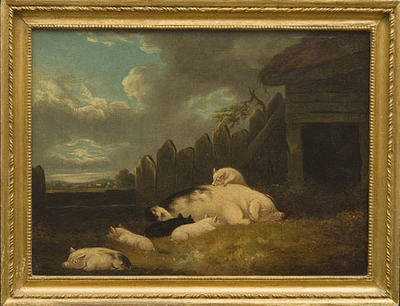Painting
Maker & role
Thomas Hand (b.circa 1771, d.1804), Attributed Artist/Maker
Production date
Post 1795
See full details
Object detail
Title
The pigsty
Production place
Collection
Measurements
0 - Whole, H: 31 x W: 41cm (H: 310 x W: 410mm); 0 - Whole, H: 36 x W: 46.5cm (H: 360 x W: 465mm)
Production notes
Thomas Hand (d.1804), George Morland (c.1763-1804) or one of their followers
Morland’s brother in law was the painter James Ward, whose paintings of animals show Morland’s influence. Both James Ward and his brother William were engravers of Morland’s views, over a hundred of which were produced. Another more notable mezzotint engraver was James Smith.
Morland’s brother in law was the painter James Ward, whose paintings of animals show Morland’s influence. Both James Ward and his brother William were engravers of Morland’s views, over a hundred of which were produced. Another more notable mezzotint engraver was James Smith.
Signature & marks
Original Clyde Bank label affixed to back: P965 / Farmhouse of George Morland / The Pigsty
Credit line
Gift, through the Australian Government’s Cultural Gifts Program, 2006
Caroline Simpson Collection, Vaucluse House Collection, Museums of History New South Wales
Caroline Simpson Collection, Vaucluse House Collection, Museums of History New South Wales
Caption
The pigsty, possibly by Thomas Hand (b.circa 1771, d.1804), George Morland (c.1763-1804) or one of their followers, after 1795
Description
Oil on canvas, possibly by Thomas Hand (d.1804), George Morland (c.1763-1804) or one of their followers showing an English farmyard scene of a sleeping sow surrounded by six black, white and piebald piglets in a sty with a ramshackle timber paling fence. A village scene is visible in the left distance and the upper right is taken up with stormclouds in the manner of Constable. Hand’s work is often confused with that of Thomas Morland, with whom he worked closely, but is distinguishable by faster and looser brushstrokes. This example is based on a signed work by Morland titled “A sow and her piglets in a farmyard” (dated 1795, location unknown): essentially the same composition, the differences being a more linear arrangement of the piglets, minor details of the sky and fencing and the addition of the village in the background.
Depictions of rural scenes and farm animals have been a genre of British painting, and printmaking, since the 18th century, ranging in style from Rococo rural fantasies and Augustan idylls to the sentimentalised views of the mid to late Victorian period. Prized stock, such as cows, bulls and even pigs, form a distinct sub genre. Pigs had appeared in artworks previously, but usually as religious or allegorical symbols of gluttony, or satirical intolerance, rather than rural prosperity. The genre was popularised by Gainsborough (1727-1788) in his ‘Cottage door’ series of works. George Morland’s views of English rural life were circulated widely as etchings, engravings and mezzotints.
Vaucluse House was originally the centre of a large semi-rural estate, comprising park and cultivated land, fields for grazing, orchards and vineyards. Stock included cattle, sheep and pigs. The rural contentment portrayed in the painting reflects the peace and plenty of the Wentworth estate, which was a place of comparative calm removed from the political and social turmoil of the family’s public life. The painting is appropriate to Vaucluse House’s private rooms (particularly as an older ‘retired’ piece) such as the nursery or second room, where it contrasts with the themes and scale of the European ‘old master’ copies seen in the drawing room and main hall.
Depictions of rural scenes and farm animals have been a genre of British painting, and printmaking, since the 18th century, ranging in style from Rococo rural fantasies and Augustan idylls to the sentimentalised views of the mid to late Victorian period. Prized stock, such as cows, bulls and even pigs, form a distinct sub genre. Pigs had appeared in artworks previously, but usually as religious or allegorical symbols of gluttony, or satirical intolerance, rather than rural prosperity. The genre was popularised by Gainsborough (1727-1788) in his ‘Cottage door’ series of works. George Morland’s views of English rural life were circulated widely as etchings, engravings and mezzotints.
Vaucluse House was originally the centre of a large semi-rural estate, comprising park and cultivated land, fields for grazing, orchards and vineyards. Stock included cattle, sheep and pigs. The rural contentment portrayed in the painting reflects the peace and plenty of the Wentworth estate, which was a place of comparative calm removed from the political and social turmoil of the family’s public life. The painting is appropriate to Vaucluse House’s private rooms (particularly as an older ‘retired’ piece) such as the nursery or second room, where it contrasts with the themes and scale of the European ‘old master’ copies seen in the drawing room and main hall.
Accession number
V2007/4



Public comments
Be the first to comment on this object record.